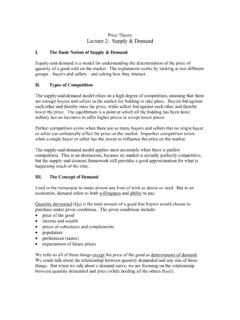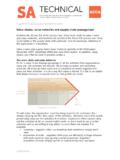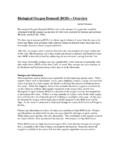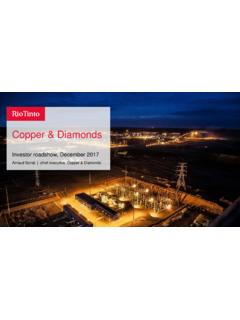Transcription of Supply Chain Processes in New Product Development
1 Chain Processes in New Product DevelopmentCollaboration in New Product Development Supply ChainsJuly 17, 2007 New Product Development is a growing area in Chinese manufacturing as both foreign and local companies develop further strategies for sustained viability. From Intel in Dalian to Ford in Nanjing, the R&D investment by foreign firms in the past couple of years has been significant. At the same time, Chinese companies are building their own capabilities by seeking out partners with specialized knowledge to help develop operational Processes even all the growth in research and new Product Development it is interesting to consider how Supply Chain Processes can be utilized to increase operational effectiveness.
2 But how many of these systems are really considered? When any new facility or process is established, a company is given an opportunity to create a Supply Chain process that facilitates resource and cost saving systems. This can importantly impact the actual Supply Chain structure as well as the internal process for new Product our look at Supply Chain operations for new Product Development we will first consider the collaborative process of integrating the operating Supply Chain behind a new Product as it is being developed. Commonly companies will request component parts from their suppliers, conceptualize and create the new Product , and then possibly weeks or months before Product launch provide demand schedules for necessary component parts.
3 Is this enough though? How would a full Supply Chain understanding improve the performance and profitability for the Product when it does reach the market?The second area we will consider is the application of Supply Chain Processes into the new Product Development phase. How can the ideas behind Supply Chain theory help companies develop more efficient models of collaboration? Here we will consider four specific areas, 1. Early Involvement of Contributors, 2. Creating a Clear Design, 3. Multiple Stages of Quality Testing, and 4. Understanding the Process of Each new Product is ready to begin Development . There is a clear market opening with high predicted consumer demand.
4 If we produce this Product and move it to market the questions asked are: What are the costs of the new Product ? What does the demand look like? When will we launch? But where are the questions regarding the Supply Chain ? What are the lead time costs? Where will inventory be held and at what cost? What are the optimal inventory levels to carry at the warehouse, retail level, manufacturing facility, or in transportation?The answer is to begin Supply Chain Development during the new Product creation phase. As marketing creates forecasted demand figures, and Product engineers play with the design and Development , including integral stakeholders such as the purchasing group and more importantly suppliers can be a critical step to better understanding both the Product and the Supply Chain as it unfolds.
5 In retail, potential customers should also be included to establish stocking and shipping inventory levels. What is the lowest cost solution for maintaining sufficient inventory? With most new products, inventory levels are kept at high levels to prevent stock-outs. In China, where new products with broad appeal leave the store faster than the manufacturer can Supply them, this strategy can be improved upon. If stock-outs are occurring, the retailer is not holding sufficient inventory levels to stock the shelves and KONG AND ALLAN KONG AND ALLAN isn't occurring fast enough. This mean lower service levels and customer fully understand the efficient inventory holding levels, a company must deeply analyze the holding costs of four potential options.
6 This could be to maintain inventory at the manufacturer's facility, in-transit inventory in shipping, an offsite warehouse for inventory, or keeping inventory at the retail location. Each comes with its own advantages and disadvantages, so we must consider these the case of the manufacturer, generally high inventory levels, if maintained onsite, will negatively impact performance as assembly lines and operating facilities are commonly not designed to carry inventory. An onsite holding location may be available, but this physical structure would be considered a warehouse. Is the location optimal for transportation or are higher costs incurred because warehousing facilities closer to the customer do not exist?
7 A warehousing facility in a location close to larger customers is another potential solution. In this case, a number of factors should be accounted for such as existing inventories that could be moved and the impacts on holding costs, the customers purchasing history, and potential transportation cost savings. These are only some examples. With this solution, adequate levels of inventory can be maintained for replenishment as needed. Employees of the warehouse can communicate frequently with the key customer based on their proximity and better understand demand requirements as inventory is sold. These individuals can act as an information transfer so that Product moves from the warehouse to fulfill demand requirements.
8 This strategy also facilitates a more efficient exchange between the warehouse and the manufacturer for continuous one must remember to include is inventory in transit. If the retailer requires a certain quantity of Product with a high probability of stock-out, then safety stock should be maintained both at the retail level and in increased frequency of delivery. But how many companies consider transportation frequency and in-transit holding levels when they are in the new Product Development phase? As these are important costs tied to the profitability of the Product these factors should be included and forecasted as inventory must also be considered here, as sufficient inventory to prevent stock-outs is one possibility, although the cost of holding inventory at the retail site is generally higher because of retail rent price.
9 In this event, coordination is critical to minimize costs and maintain sufficient inventory levels to satisfy customer may all seem like a waste of time, however consider a recent story I was told. A large global company in the water heater and engine motor industry does over $2 Billion in sales annually. The company has manufacturing facilities around the world and a warehousing network to maintain low inventory costs across all their Product segments. In one warehousing location however, they realized inventory management policies in place could not tell them what Product was held there. How does this scenario impact the Supply Chain ?
10 In the case of new Product Development imagine the negative effects this example can have. Demand levels are growing rapidly, but the company doesn't even know how much Product they have for replenishment. Major stock-outs are likely to occur, service levels will undoubtedly be low, and lead times are uncertain because there is no knowledge of what products need to be reordered or where those products might be located. In this case, the loss of information critically inhibits the company from operating at efficient the new Product Development phase and examples like this, the lack of Supply Chain information incorporated into planning can create dramatic lost potential revenues.




